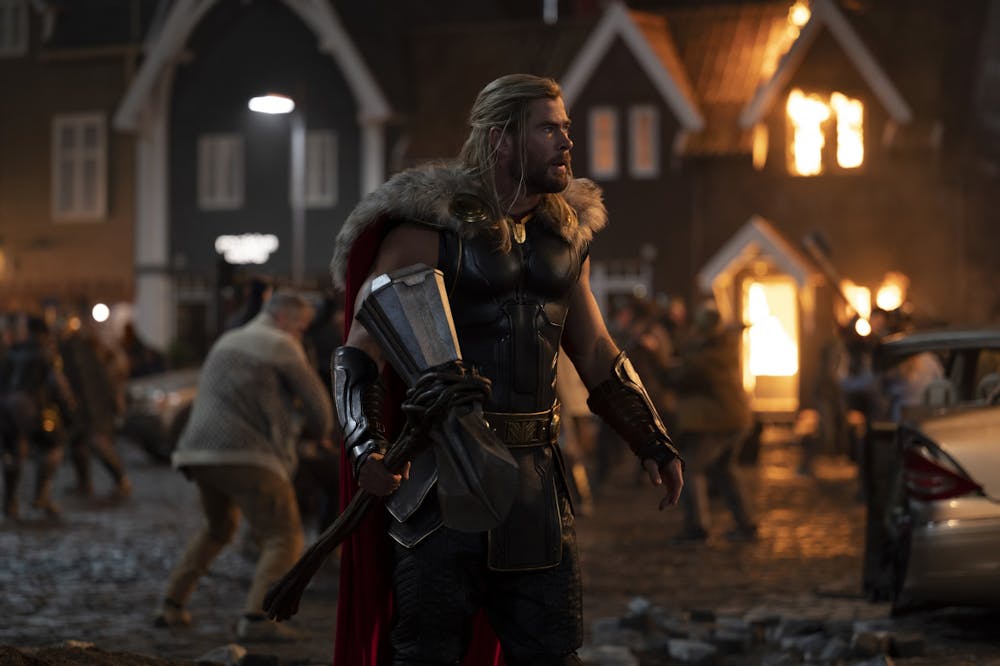“Thor: Love and Thunder” was released in theaters July 8, making it the latest installment in the Marvel Cinematic Universe’s Phase 4. Thor (Chris Hemsworth) is without purpose after the events of the Infinity Saga and in order to find inner peace, he must first defeat Gorr the God Butcher (Christian Bale) and reconnect with his old flame, Jane Foster (Natalie Portman).
The film is drenched in Taika Waititi’s signature comedic style and a lighthearted tone that accentuates the film’s core themes. It’s not without its emotional moments, though.
Much like Waititi’s other films, including the Oscar-winning “Jojo Rabbit,” the film's pathos is very much alive. We see this in Christian Bale’s fantastic (and underutilized) performance, as he easily balances the sinister energy of the fearsome villain and his empathetic backstory.
The usage of classic rock in the soundtrack is another trademark Waititi-ism. Interspersed between scenes are various Guns N’ Roses hits that give the film the same classic rock-driven nostalgia and timelessness that Waititi’s “Thor: Ragnarok” had.
Unfortunately, that’s where my praise for “Thor: Love and Thunder” ends.
The film isn’t unenjoyable to watch. In fact, I had a lot of fun in the theater. The problem, however, is that the film is 2 hours of pure fluff. As we were being spoon-fed yet another joke about screaming goats, I couldn’t help but ask myself, “why does any of this matter?”
This seems to be the general problem with Phase 4 of the MCU. There’s no overarching direction or endgame that these movies are pointing to. Previous phases were building up to the Infinity Saga, but even halfway through Phase 4, we still have no idea where all of this is going. Many believed that “Doctor Strange in the Multiverse of Madness” would offer some sort of guidance, but instead, the film ended in a rather insignificant and forgettable way.
The lack of direction makes watching these films a particularly tedious task. In a franchise that demands your attention with viewing guides and “know before you watch” lists, it doesn’t seem fair to offer no sense of importance or a grander story in return, especially when all of these films follow the same general format and plot structure.
Most of the jokes in “Thor: Love and Thunder” are barely funny enough to garner a light chuckle. While watching, you realize that these jokes are taking screen time away from what would be important plot points and character development. The shell of a good film is there, but it gets bogged down by the low stakes, forgettable storyline and poor visual effects.
For a film that had a budget of around a quarter of a billion dollars, the quality of the visual effects and shot composition is jarring. Many of the VFX-heavy shots are crowded and unappealing to look at. Even in simple conversation scenes that use visual effects, the background and foreground are so disconnected that the frame looks completely flat.
The visual effects artists are not to blame here. Since the release of the film, some artists have come forward to talk about their experiences working on Marvel productions, stating that they’re overworked and underpaid by the studio. Marvel Studios is notorious for being a difficult visual effects client to work with because they do not give the visual effects studios enough time or resources to complete the effects.
It hasn’t always been like this. “Thor: Ragnarok,” which came out in 2017, is better than “Thor: Love and Thunder” in virtually every way possible. “Ragnarok” is more in line with Waititi’s other works, whereas “Love and Thunder” feels like the product of too much studio interference and a lack of passion.
Overall, “Thor: Love and Thunder” is a perfectly fine, fun summer blockbuster. It delivers on the promise of a good time and plenty of jokes, even if they don’t completely stick the landing. However, one can’t help but begin to feel the fatigue spawned from too much of the same thing. If Marvel wants to keep our interest piqued, they need to work through the current identity crisis they’re having.






